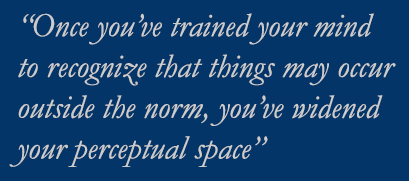We’ve all experienced instances where an obvious sign has been missed. Notwithstanding our most careful scrutiny, something obvious gets neglected or ignored. It’s present, it’s visible, but we cannot recognize it. Psychologists have a name for this––inattentional blindness.
“Inattentional blindness, also known as perceptual blindness, is a psychological lack of attention that is not associated with any vision defects or deficits. It may be further defined as the event in which an individual fails to perceive an unexpected stimulus that is in plain sight. When it simply becomes impossible for one to attend to all the stimuli in a given situation, a temporary blindness effect can take place as a result; that is, individuals fail to see objects or stimuli that are unexpected and quite often salient.”[1]
There’s medical literature that describes this phenomenon in the context of surgery. The use of enhanced methods of seeing––such as computerized image guidance displays––gives rise to greater detail, but paradoxically also increases the likelihood that something obvious will be missed. “The use of augmented reality has been reported to be associated with inattentional blindness in surgeons, raising important safety concerns. Dixon et al. compared 32 surgeons of varying experience performing an endonasal navigation exercise on a cadaver. Surgeons were randomized into groups performing the exercise with or without augmented reality. Although surgeons in the group using augmented reality were more accurate, they were less likely to identify unexpected findings. The authors of the study speculated that augmented reality may have led to perceptual blindness in a number of ways, including attentional tunneling, increased visual clutter and jitter, and an additional camouflage effect. In the present study, all image guidance displays resulted in considerable inattentional blindness (p = 0.003), despite the surgical clip being clearly visible in all the videos reviewed. Interestingly, image guidance with existing triplanar displays also resulted in comparable inattentional blindness (40% recognition of unexpected findings), suggesting that it is the cognitive load rather than the overlay per se that is important.”[2]
The surgical clip “being clearly visible in all the videos reviewed” was missed notwithstanding it was obvious once its presence was known. The “cognitive load” of searching for something else  made it very easy to miss something obvious yet unanticipated.
made it very easy to miss something obvious yet unanticipated.
During litigation inattentional blindness can easily take hold. In the blur of events, it’s easy to miss something readily evident. Is there a way to avoid this perceptual blind spot? There is. It hinges on coming to terms with our aversion to being surprised. Surprise is not typically something we seek out. We tend to avoid surprises. We avoid them because they unsettle our expectations, disrupt our routines. But a slightly adjusted mindset can actually embrace surprise, seek it out, look for it. Thus, one way of becoming more observant is simply to expect the unexpected in complex circumstances.
Another way is to develop a sense of “open-mindedness”––a willingness to accept that things may not turn out as expected. Once you’ve trained your mind to recognize that things may occur outside the norm, you’ve widened your perceptual space. You can see beyond because you’ve created a wider horizon.
Still another way is to reduce our cognitive load. If we can lessen the extent of our “attentional clutter” we can free up space to perceive things we otherwise might have missed. “It takes an extraordinary intelligence to contemplate the obvious,” said Alfred North Whitehead. Too often we neglect to contemplate the obvious, searching with “attentional tunneling” to find that which is hidden or obscured while all along the truth lingers unobserved and unnoticed right before our eyes. It’s present, it’s visible––all we have to do is see it.
[1] Inattentional Blindness, Wikipedia,
https://en.wikipedia.org/wiki/Inattentional_blindness
[2] Marcus HJ, Pratt P, Hughes-Hallett A, Cundy TP, Marcus AP, Yang GZ, Darzi A, Nandi D., Comparative effectiveness and safety of image guidance systems in neurosurgery: a preclinical randomized study, Journal of Neurosurgery pgs. 307-313 (Vol. 123, No. 2, August 2015) http://thejns.org/doi/full/10.3171/2014.10.JNS141662




